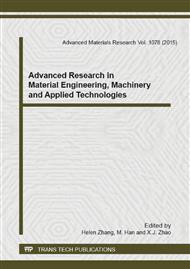[1]
M. d'Amorim and K. Havelund. Event-based runtime verification of Java programs. ACM SIGSOFT Software Engineering Notes, pp.1-7, 30(4), (2005).
DOI: 10.1145/1082983.1083249
Google Scholar
[2]
Chen, F., D'Amorim, M., Roşu, G.: Checking and correcting behaviors of Java programs at runtime with JavaMOP. In: Runtime Verification (RV 2006). ENTCS, vol. 144, pp.3-20 , (2006).
DOI: 10.1016/j.entcs.2006.02.002
Google Scholar
[3]
X. Zhang, M. Leucker and W. Dong, Runtime verification with predictive semantics. Lecture Notes in Computer Science, pp.418-432, (2012).
DOI: 10.1007/978-3-642-28891-3_37
Google Scholar
[4]
Chen, F., Şerbănuţă, T.F., Roşu, G. jPredictor: a predictive runtime analysis tool for Java. In: International Conference on Software Engineering (ICSE 2008), pp.221-230. ACM, New York, (2008).
DOI: 10.1145/1368088.1368119
Google Scholar
[5]
K. Yu, Zb Chen and W. Dong, A Predictive Runtime Verification Framework for Cyber-Physical Systems. In International Workshop on Safety and Security in Cyber Physical Systems (2014).
DOI: 10.1109/sere-c.2014.43
Google Scholar
[6]
Jvmti. http: /docs. oracle. com/javase/1. 5. 0/docs/guide/jvmti/jvmti. html.
Google Scholar
[7]
Vallee-RaiR. Soot:A Java Bytecode Optimization Framework. October, 2000. http:/www. sable. mcgill. ca/pubIications/thesis/Reference.
Google Scholar
[8]
Blackburn, S.M., Garner, R., Hoffman, C., Khan, A.M., McKinley, K.S., Bentzur, R., Diwan, A., Feinberg, D., Frampton, D., Guyer, S.Z., Hirzel, M., Hosking, A., Jump, M., Lee, H., Moss, J.E.B., Phansalkar, A., Stefanović, D., VanDrunen, T., von Dincklage, D., Wiedermann, B.: The DaCapo benchmarks: Java benchmarking development and analysis. In: Object-Oriented Programming, Systems, Languages and Applications (OOPSLA 2006), p.169–190. ACM, New York, (2006).
DOI: 10.1145/1167473.1167488
Google Scholar
[9]
A. Bauer, M. Leucker and C. Schallhart. Runtime verification for LTL and TLTL. ACM Transactions on Software Engineering and Methodology (TOSEM), vol. 20, p.14, (2011).
DOI: 10.1145/2000799.2000800
Google Scholar
[10]
AspectJ. http: /eclipse. org/aspectj.
Google Scholar


